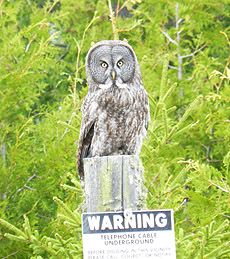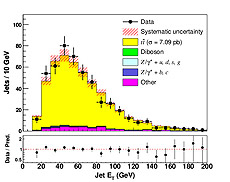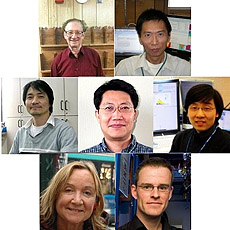|
Have a safe day!
Thursday, June 6
2:30 p.m.
Theoretical Physics Seminar - Curia II
Speaker: Juan Herrero-Garcia, University of Valencia
Title: On the Dark Matter Annual Modulation Signal
3:30 p.m.
DIRECTOR'S COFFEE BREAK - 2nd Flr X-Over
4 p.m.
Accelerator Physics and Technology Seminar (NOTE DATE, LOCATION) - AD X-Gallery
Speaker: Richard D'Arcy, University College of London
Title: Front End Test Stand (FETS): RFQ Simulations and MEBT Beam Diagnostics
Friday, June 7
3:30 p.m.
DIRECTOR'S COFFEE BREAK - 2nd Flr X-Over
THERE WILL BE NO JOINT EXPERIMENTAL-THEORETICAL PHYSICS
SEMINAR THIS WEEK
Click here for NALCAL,
a weekly calendar with links to additional information.
Ongoing and upcoming conferences at Fermilab |
|
Thursday, June 6
- Breakfast: Canadian bacon, egg and cheese Texas toast
- Breakfast: Mexican omelet
- Steak soft tacos
- Smart cuisine: baked penne with chicken and mushrooms
- Stuffed boneless pork chops
- Turkey bacon panini
- Sweet and sour chicken
- Chef's choice soup
- New Brunswick stew
- Assorted pizza by the slice
Wilson Hall Cafe menu |
|
Friday, June 7
Dinner
Closed
Wednesday, June 12
Lunch
- Northern Italian lasagna
- Caesar salad
- Tiramisu
Chez Leon menu
Call x3524 to make your reservation.
|
|
Unification of forces
 |
What if, like the individual threads that form a piece of cloth, all of nature's forces can be woven together into one comprehensive force? Image: Sandbox Studio
|
The unification of forces is the idea that it's possible to view all of nature's forces as manifestations of one single, all-encompassing force.
Scientists have made great strides toward the goal of understanding how the forces can be combined. Newton realized in the 17th century that the same gravitational force that describes an apple falling from a tree also describes the moon's orbit around Earth. Then, in the 19th century, James Clerk Maxwell demonstrated that the electric and magnetic forces are aspects of a single electromagnetic force. Finally, in the 20th century, Steven Weinberg, Abdus Salam and Sheldon Lee Glashow discovered that, at high energies, the electromagnetic and weak force—without which the sun wouldn't shine—merge into a single electroweak force.
Today, scientists seek to unify this with the strong force—without which the nucleus of an atom wouldn't hold together—under a Grand Unified Theory. Unfortunately, the predicted energy at which these forces would experimentally combine is about 100 billion times the energy produced by today's most powerful particle accelerators. And even if we succeed in figuring out how the strong force fits into the puzzle, we will still need to look to even higher energies to combine these forces with gravity. But it will be worth it. Understanding whether the known subatomic forces have a common origin is key to creating a Theory of Everything.
—Nitesh Soni, University of Adelaide
Read similar explanations in the symmetry archive
|
Changes to site entrance gate hours of operation beginning Monday
Because of a sequestration-related reduction to the Fermilab site security budget, entrance gate hours of operation will be reduced beginning June 10. The entrance gates are staffed by a contracted third-party provider, which also provides security patrolling and response at Fermilab 24/7.
The new site entrance gate hours of operation are:
Pine Street gate: No change to hours; it will remain open 24/7.
Batavia Road gate: New hours are 6:30 a.m. to 11 p.m., 7 days a week (reduced from 5 a.m. to 1 a.m.).
Wilson Street gate: New hours are 6:30 a.m. to 3:30 p.m., Monday through Friday (reduced from 6 a.m. to 6 p.m.).
Please note that truck traffic entering or leaving the Fermilab site after 3:30 p.m. will use the Pine Street gate. An exception applies to the passage of cryo trucks and farm vehicles, which will continue the current arrangement of using the Wilson Street gate.
While the security-related budget has been affected, the level of services provided by security officers throughout the site will remain largely unchanged, with the exception of the reduced entrance gate hours. The safety of our staff, users and visitors is of the utmost importance, and every effort has been made to minimize the impact and inconvenience.
Signage will be placed throughout the site as a reminder of the revised entrance gate hours. As always, please dial x3131 if you need to reach the Security Department in the event of an emergency or if you need assistance.
If you have questions regarding the entrance gate hours, contact Bill Flaherty, Fermilab security chief, at x4507 or at flaherty@fnal.gov.
|
Owl is watching you
 |
A great gray owl in Ash River, Minn., near the site of the NOvA Far Detector, gives a warning look. Photo: Gary Crutcher, PPD |
|
Sanford Lab officials outline LBNE plans
From Black Hills Pioneer, June 3, 2013
LEAD — Scientists plan to build what they consider to be one of the most important physics experiments in the world in Lead if an environmental impact study is favorable to the project. The project could be built on the surface, in Kirk Canyon, or underground at the Sanford Lab, but federal officials want to make sure they understand the environmental effects before proceeding any farther.
Read more |
|
A pure sample
 |
Distribution of the transverse-energy values for the two jets with the largest transverse energy in each event (black points) for the signal sample. The lower panel shows the observed data yield divided by the predicted yield.
|
An important part of the Tevatron's legacy is the discovery of the top quark and subsequent
determinations of its intrinsic properties. Here we make the first measurement of the top-antitop cross section using the full Run II data set. The top-antitop cross sections give the probabilities for its various decay processes to occur and are a function of the particles' energy. (For the Tevatron the energy in the center-of-mass system is 1.96 TeV, and for the LHC it is currently 8 TeV.)
The top essentially always decays into a W and a b quark, and the W then decays into either two light quarks or into a lepton and a neutrino. In this experiment CDF looked at the decay mode in which the W from the top and the W from the antitop each decays into a lepton plus neutrino. The final state consists of two leptons, two neutrinos, and two b quarks. This is the dilepton decay mode.
Because of the presence of two leptons (electron or muon), a large amount of missing energy carried by the two neutrinos and the presence of four or more jets, this is an easy mode to recognize. However, this is the rarest of the decay modes. Another way of saying that this is an easy mode to recognize is to say that the signal to background is large. In an earlier paper on dilepton cross sections, we reported a signal of about 70 percent; the remaining 30 percent was the background. By requiring a very positive identification of at least one b-tagged jet, we have now improved the percentage of signal to slightly more than 90 percent.
The full sample consists of 246 events, and a typical distribution is shown in the top figure. The result of our measurement for a top mass of 172.5 GeV/c2 is
σtt (CDF dilepton) = 7.09 ± 0.84 picobarns. When all CDF and DZero measurements are combined, σtt (CDF + DZero) = 7.60 ± 0.41 picobarns.
Theorists' ability to calculate the Standard Model has also recently improved, and the latest result is σtt (theory) = 7.35 ± 0.24 picobarns. We see that there is very good agreement between the combined Tevatron measurement and the Standard Model prediction.
Learn more
—edited by Andy Beretvas
 |
Top row, from left: Andy Beretvas (Fermilab), Yen-Chu Chen (Academia Sinica, Republic of China). Middle row: Hyunsoo Kim (Chonbuk National University, Korea),
Soo-Bong Kim (Seoul National University, Korea), Chang-Seong Moon (Université Paris 7/CNRS).
Bottom row: Aurore Savoy-Navarro (Université Paris 7/CNRS) and Homer Wolfe (The Ohio State University).
|
|
|